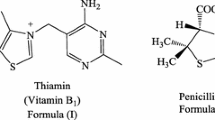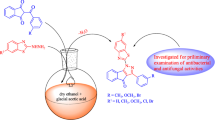Abstract
Several 2-[[(benzoxazole/benzimidazole-2-yl)sulfanyl]acetylamino]thiazoles derivatives were synthesized by reacting 4-substituted-2-(chloroacetylamino)thiazoles with benzoxazole/benzimidazole-2-thioles in acetone and in the presence of K2CO3. The chemical structures of the compounds were elucidated by IR,1H-NMR, and FAB+-MS spectral data. Their antimicrobial activities againstMicrococcus luteus (NRLL B-4375),Bacillus cereus (NRRL B-3711),Proteus vulgaris (NRRL B-123),Salmonella typhimurium (NRRL B-4420),Staphylococcus aureus (NRRL B-767),Escherichia coli (NRRL B-3704),Candida albicans and Candida globrata (isolates obtained from Osmangazi Uni. Fac.of Medicine) were investigated and in this investigation, a significant level of activity was illustrated.
Similar content being viewed by others
References
Alexander, B. D. and Perfect, J. R., Antifungal resistance trends towards the year 2000 Implications for therapy and new approaches.Drugs, 54, 657–678 (1997)
Amyes, S. G. B. and Gemmell, C. G., Antibiotic resistance-Proceedings of a symposium held on 12 July 1996 at the University of Southampton.J. Med. Microbiol., 46, 436–470 (1997)
Ates, Ö., Altintas, H. and Ötük, G., Synthesis and antimicrobial activity of 4-carbethoxymethyl-2-[(alpha-haloacyl)amino] thiazoles and 5-nonsubstituted/substituted 2-[(4-carbethoxymethylthiazol-2-yl) imino]-4-thiazolidinones.Arzneim. Forsch., 50, 569–575 (2000).
Cassell, G. H. and Mekalanos, J., Development of antimicrobial agents in the era of new and reemerging infectious diseases and increasing antibiotic resistance.J. Am. Med. Assoc., 285, 601–605 (2001).
Cetinkaya, Y., Falk, P., and Mayhall, C.G., Vancomycin-resistant enterococci.Clin. Microbiol. Rev., 13, 686–707 (2000).
Chu, D. T. W., Plattner, J. J., and Katz, L., New directions in antibacterial research.J. Med. Chem., 39, 3853–3874 (1996).
Cunha, B. A., Antibiotic resistance.Drugs Today, 34, 691–698 (1998).
Doern, G. V., Antimicrobial use and the emergence of antimicrobial resistance with Streptococcus pneumoniae in the United States.Clin. Infect. Dis., 33, 187–192 (2001).
Goodman-Gilman, A.,The pharmacological basis of therapeutics. McGraw-Hill company, USA, (2001).
Gringauz, A.,Introduction to Medicinal Chemistry, How Drug Act and Why, Wiley-VCH Inc., USA (1997).
Healy, V. L., Lessard, I. A. D., Roper, D. I., Knox, J. R. and Walsh, C. T., Vancomycin resistance in enterococci: reprogramming of the D-Ala-D-Ala ligases in bacterial peptidoglycan biosynthesis.Chem. Biol., 7, 109–119 (2000).
Hood, S. and Denning, D. W., Treatment of fungal infection in AIDS,J. Antimicrob. Chemoth., 37, 71–85 (1996).
Hubschwerlen, C., Pflieger, P., Specklin, J. L., Gubernator, K., Gmunder, H., Angehrn, P., and Kompis, I., Pyrimido[1,6a] benzimidazoles: a new class of DNA gyrase inhibitors.J. Med. Chem., 35, 1385–1392 (1992).
Joule, J. A. and Mills, K.,Heterocyclic Chemistry, Blackwell Science Ltd., Oxford, (2000)
Kim J. S., Sun, Q., Gatto, B., Yu, C., Liu, A., Liu, L. F., and LaVoie, E. J., Structure-activity relationships of benzimidazoles and related heterocycles as topoisomerase I poisons.Bioorg. Med. Chem., 4, 621–630 (1996).
Koneman, E. W., Allen, S. D., and Winn, W. C.,Colour Atlas and Textbook of Diagnostic Microbiology, Lippincott Raven Pub., Philadelphia, (1997).
Lakhan, R., Sharma, B. P., and Shukla, B. N., Synthesis and antimicrobial activity of 1-aryl-2-amino-3-(4-arylthiazol-2-yl)/(benzothiazol-2-yl) guanidines.Farmaco, 55, 331–337 (2000).
Levy, S. B., The challenge of antibiotic resistance.Sci. Am., 278, 46–53 (1998).
Lipsitch, M., The rise and fall of antimicrobial resistance.Trends Microbiol., 9, 438–444 (2001).
Lopez-García, B., Veyrat, A., Peŕez-Payá, E., González-Candelas, L., and Marcos, J. F., Comparison of the activity of antifungal hexapeptides and the fungicides thiabendazole and imazalil against postharvest fungal pathogens.Int. J. Food Microbiol., 89, 163–170, (2003)
Marchese, A., Schito, G. C., and Debbia, E. A., Evolution of antibiotic resistance in gram-positive pathogens.J. Chemotherapy, 12, 459–462 (2000).
Onoe, H. and Takahashi, H.,Jpn. Kokai. Tokkyo Koho JP 03 87, 841 (1994).Chem. Abstr., 121, 205336 (1994).
Pandeya, S. N., Sriram, D., and Nath, G., Synthesis, antibacterial, antifungal and anti-HIV activities of Schiff and Mannich bases derived from isatin derivatives andN-[4-(4′-chlorophenyl) thiazol-2-yl] thiosemicarbazide.Eur. J. Pharm. Sci., 9, 25–31 (1999).
Perrin, L., Rakik, A., Yerly, S., Baumberger, C., Kinlochde-Loes, S., Pechere, M., and Hirschel, B., Combined therapy with zidovudine and L-697, 661 in primary HIV infection.AIDS, 10, 1233–1237 (1996).
Rapp, R. P., Antimicrobial resistance in gram-positive bacteria: The myth of the MIC.Pharmacotherapy, 19, 112–119 (1999).
Rybak, M. J. and Akins, R. L., Emergence of methicillin-resistant Staphylococcus aureus with intermediate glycopeptide resistance-Clinical significance and treatment options.Drugs, 6, 1–7 (2001).
Silverman, R. B.,Organic chemistry of Drug Desing and Drug Action, Academic press, San Diego, (1992).
Thompson, L. A. and Ellman, J. A., Synthesis and applications of small molecule libraries.Chem. Rev., 96, 555–600 (1996).
Turan-Zitouni, G. and Kaplancikli, Z. A., Some new 2,3-dihydro-3-benzofuranamine derivatives.Boll. Chim. Farmaceutico, 137, 367–371 (1998).
Turan-Zitouni, G., Demirayak, S., Özdemir, A., Kaplancikli, Z. A., and Yildiz, M. T., Synthesis of some 2-[(benzazole-2-yl) thioacetylamino]thiazole derivatives and their antimicrobial activity and toxicity.Eur. J. Med. Chem., 39, 267–272 (2004).
Author information
Authors and Affiliations
Corresponding author
Rights and permissions
About this article
Cite this article
Kaplancikli, Z.A., Turan-Zitouni, G., Revial, G. et al. Synthesis and study of antibacterial and antifungal activities of Novel 2-[[(benzoxazole/benzimidazole-2-yl)sulfanyl] acetylamino]thiazoles. Arch Pharm Res 27, 1081–1085 (2004). https://doi.org/10.1007/BF02975108
Received:
Issue Date:
DOI: https://doi.org/10.1007/BF02975108




